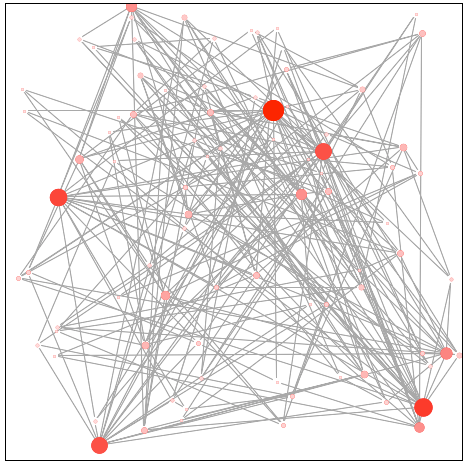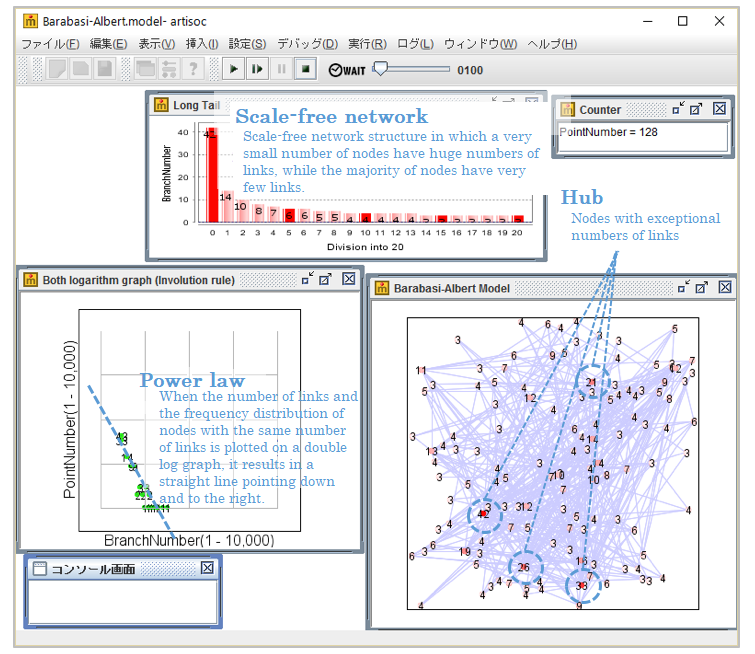MAS models
Barabási–Albert model
What is the Barabási–Albert model?
Networks with a structure in which some nodes have a huge number of links, but in which nearly all nodes are connected to only a few other nodes, are called scale-free networks.
Scale-free networks can be observed everywhere in society, such as in air transport networks and power grids, in relation to academic citations, and in web-related links.
In 1999, Albert-László Barabási and his student, Réka Albert, proposed a network model (the BA model) that used a realistic approach to generating networks that realize scale-free properties.
The two characteristics of the BA model were “network growth” and “preferential attachment.”
If nodes are connected one after the other to a network (growth), and the newly added nodes are attached to pre-existing nodes with equal probability, it is not a scale-free network. In a BA model, by making it easy to connect to nodes that have higher degrees at that point in time (preferential attachment), peaks with high degrees subsequently find it easier to gain new links and to become hubs, thus realizing scale-free properties.

Reproducing scale-free networks
We will use simulation to observe the process by which scale-free networks are created.
The Barabási–Albert model rules are defined as follows.
① The network starts from 1 node (or from a number of mutually interconnected nodes).
② A new node is added. A link is extended from this node to one of the nodes that already exists. At this point, the probability of the link being attached is proportional to the number of links to the respective nodes at that point in time.
③ Step ② is repeated until the number of nodes reaches a designated value.
Using the model described above, the process by which a scale-free network is created can be observed in the simulation.

Registration with artisoc Cloud is required to run the model.
Model points of interest
・Existence of “hubs”
Nodes with exceptional numbers of links are called “hubs.” Hubs have enormous power to influence, such as when a product recommended by a popular blogger takes off, or when a rumor spreads suddenly.
・Power law
When the number of links and the frequency distribution of nodes with the same number of links is plotted on a double log graph, it results in a straight line pointing down and to the right, which is said to obey the “power law.” The relationship between the magnitude of earthquakes and the frequency of occurrence is also closely related to the power law.
・Scale-free networks
A network structure in which a very small number of nodes have huge numbers of links, while the majority of nodes have very few links, is called a “scale-free network.” Conversely, networks that have a structure in which every node has a similar number of links are called “random networks.”
Further reading
[1] Barabasi, A.-L., and Albert, R., Emergence of scaling in random networks, Science 286, 1999, pp. 509-512.
[2] Albert-laszlo Barabasi, Jennifer Frangos, Linked: The New Science Of Networks Science Of Networks, Basic Books (2002/5/14), ISBN 0738206679
[3] Albert-László Barabási, “Linked: the New Science of Networks”, Perseus Books Group, 2002, ISBN 4-14-080743-1
[4] Naoki Masuda, Norio Konno, “Fukuzatsu network - kiso kara oyo made”, Kindai Kagakusha, April 2010, ISBN 978-4-7649-0363-0
|
Barabási–Albert model basic information [Model title]: Barabási–Albert model (BA model)[Model designers]: Barabasi, A.-L., and Albert, R. [Year model announced]: 1999 [artisoc sample model creation]: KOZO KEIKAKU ENGINEERING Inc., Masaki Tamada [artisoc sample model creation date]: October 2006 |



